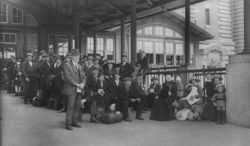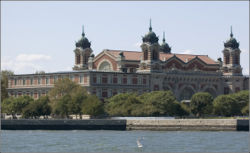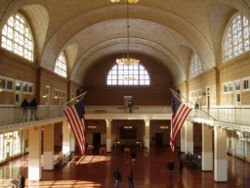Ellis Island
Ellis Island, at the mouth of the Hudson River in New York Harbor, was at one time the main entry facility for immigrants entering the United States in the late 19th and early 20th centuries. Ellis Island is within the boundaries of Jersey City, New Jersey but is legally part of New York under the 1834 treaty setting the boundary between the two states. However, due to landfill which has expanded the island's 1834 boundaries, the island is divided between New York and New Jersey. It is wholly in the possession of the Federal government as a part of Statue of Liberty National Monument, however, and is under the jurisdiction of the U.S. National Park Service. According to the United States Census Bureau, the island, which was largely artificially created through the landfill process, has an official land area of 129,619 square meters, or 32 acres, more than 83 percent of which lies in the city of Jersey City. The natural portion of the island, lying in New York City, is 21,458 square meters (5.3 acres), and is completely surrounded by the artificially created portion. For New York State tax purposes it is assessed as Manhattan Block 1, Lot 201. Since 1998, it has also a tax number assigned by the state of New Jersey.
The Ellis Island Immigrant Station was designed by architects Edward Lippincott Tilton and William Boring. They received a gold medal at the 1900 Paris Exposition for the building's design.
History
Ellis Island takes its name from Samuel Ellis, a colonial New Yorker, possibly from Wales, who owned the island during the late 1700s and kept a tavern, serving sailors and local fishermen. Samuel Ellis was a local farmer and merchant.
The federal immigration station opened on January 1, 1892 and was closed in November 12, 1954, but not before 12 million immigrants, were inspected there by the U.S. Bureau of Immigration (Immigration and Naturalization Service)(the estimates for immigrants processed there may have been as high as 20 million, but this is unsubstantiated). In the 35 years before Ellis Island opened, over eight million immigrants had been processed locally by New York State officials at Castle Garden Immigration Depot in Manhattan. Many who were allowed entry settled in New York and northern New Jersey for at least their first few years in America, but left the area for inland and other coastal destinations in the USA and Canada. During the period 1910 to 1940, Angel Island (between Alcatraz and the Pacific Ocean in San Francisco Bay) was opened on the West Coast; there some 175,000 foreigners were inspected, mostly Chinese. Other immigration stations that were as prominent as San Francisco's (but much less active than Ellis Island) were located at New Orleans, Seattle, Boston, Philadelphia and Baltimore.
Ellis Island was one of 30 processing stations opened by the federal government. It was the major processing station for third class/steerage immigrants entering the United States in 1892; it processed 70% of all immigrants at the time. Wealthy immigrants that traveled first class and second class would get automatic entry into the United States. First they had to pass a six second physical examination. Those with visible health problems or diseases were sent home or held in the island's hospital facilities for long periods of time. Next they were asked 29 questions including name, occupation, and the amount of money they carried with them. Generally those immigrants who were approved spent from three to five hours at Ellis Island. However more than three thousand would-be immigrants died on Ellis Island while being held in the hospital facilities. Some unskilled workers and immigrants were rejected outright because they were considered "likely to become a public charge." About 2 percent were denied admission to the U.S. and sent back to their countries of origin for reasons such as chronic contagious disease, criminal background, or insanity.[1]
Writer Louis Adamic came to America from Slovenia in southeastern Europe in 1913. Adamic described the night he spent on Ellis Island. He and many other immigrants slept on bunk beds in a huge hall. Lacking a warm blanket, the young man "shivered, sleepless, all night, listening to snores" and dreams "in perhaps a dozen different languages".
After 1924, with demands for further immigration restrictions, "The Quota Laws" would be passed and they would have a major impact on immigration. After they were passed Ellis Island was used only sporadically for immigration. It would be mostly used for detainees and refugees. Italians were detained, Japanese were interned, but the major group to be detained were German Americans during World War II falsely accused of being Nazis. The United States would begin processing immigrants in the embassies and consulates of the emigrant country.
As with all historic areas administered by the National Park Service, Ellis Island, along with the Statue of Liberty, was listed on the National Register of Historic Places on October 15, 1966.
Today Ellis Island houses a museum reachable by ferry from Liberty State Park in Jersey City, New Jersey and from the southern tip of Manhattan in New York City. The Statue of Liberty, sometimes thought to be on Ellis Island because of its symbolism as a welcome to immigrants, is actually on nearby Liberty Island, which is about 1/2 mile to the South.
More than 20 million immigrants passed through Ellis Island between 1892 and 1954. Today, over 100 million Americans can trace their ancestry to the immigrants who first arrived in America through the island before dispersing to points all over the country. Because some immigrants were refused entry to the United States, Ellis island was also known as "The Isle of Tears" or "Heartbreak Island."[2]
Federal Jurisdiction and the Dispute over State Sovereignty
On October 15, 1965, Ellis Island was proclaimed a part of Statue of Liberty National Monument, which is managed by the National Park Service. The island is on the New Jersey side of the Hudson River. During the colonial period, however, New York had taken possession, and New Jersey had acquiesced in that action. In a compact between the two states, approved by U.S. Congress in 1834, New Jersey therefore agreed that New York would continue to have exclusive jurisdiction over the island.
Thereafter, however, the federal government expanded the island by landfill, so that it could accommodate the immigration station that opened in 1890 (and closed in November 1954). Landfilling continued until 1934. Nine-tenths of the current area is artificial island that did not exist at the time of the interstate compact.
New Jersey contended that the new extensions were part of New Jersey, since they were not part of the previous cession. New Jersey eventually filed suit to establish its jurisdiction, leading New York City Mayor Rudolph Giuliani dramatically to remark that his father, an Italian who immigrated through Ellis Island, never intended to go to New Jersey.
The dispute eventually reached the Supreme Court, which ruled in 1998 that New Jersey had jurisdiction over all portions of the island created after the original compact was approved. This caused several immediate problems: some buildings, for instance, fell into the territory of both states. New Jersey and New York soon agreed to share claims to the island. It remains wholly a Federal property, however, and none of this legal maneuvering has resulted in either state taking any fiscal or physical responsibility for the maintenance, preservation, or improvement of any of the historic properties that make the island so significant in the first place.
Museum
The main building now houses a museum in addition to being a historic site. It is legally in New York state, while the southern part of the island, which holds the unrestored infirmary and hospital buildings, was given back to New Jersey in the court settlement.
There is a bridge between Ellis Island with Liberty State Park in Jersey City. It was built during the restoration of the island and heavy trucks went across it. In 1995 proposals were made to open it to pedestrians or to build a new bridge for pedestrians. They were defeated by two vested interests: the City of New York and the private operator of the only boat service to the island, the Circle Line. The supposedly inadequate bridge is still in use but closed to the public.[3]
Popular Beliefs
Beliefs about Ellis Island abound, some unsubstantiated. Among the most asserted among them are that government officials compelled immigrants to take new names against their wishes. However no historical records bear this out. Actually, federal immigration inspectors were under strict bureaucratic supervision and were more interested in preventing inadmissible aliens from entering the country (which they were held accountable for) rather than assisting them in trivial personal matters such as altering their names. In addition, the inspectors used the passenger lists given them by the steamship companies to process each foreigner. These were the sole immigration records for entering the country and were prepared not by the U.S. Bureau of Immigration but by the steamship companies.[4]
Other false claims suggest Albert Einstein and Fiorello LaGuardia passed through the station as immigrants, and that the anti-Italian expression "wop" was a shortened form meaning "without papers."
References
- ↑ National Park Service: Ellis Island, retrieved January 12, 2006.
- ↑ Davis, Kenneth (2003), Don't Know Much About American History, HarperTrophy, ISBN 0064408361 ("Isle of Tears" or "Heartbreak Island," p. 123)
- ↑ Setha Low, Dana Taplin, Suzanne Sheld (2005), Rethinking Urban Parks, University of Texas Press; chapter 4.
- ↑ http://149.101.23.2/graphics/aboutus/history/articles/nameessay.html American Names / Declaring Independence, Marian L. Smith, INS Historian, US Citizenship and Immigration Services, last updated January 20, 2006, accessed May 22, 2007


